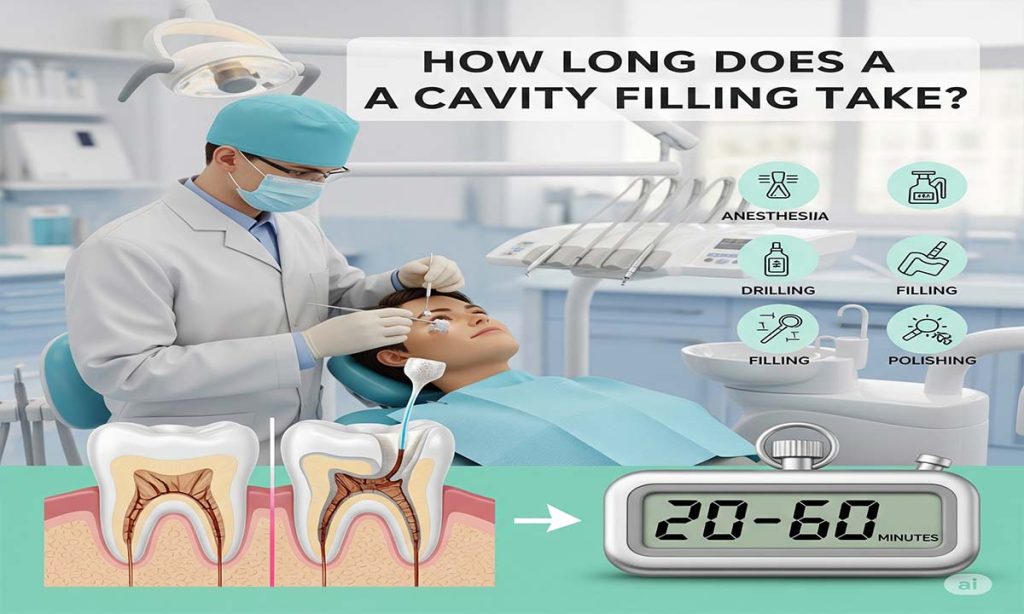A cavity filling is a routine dental procedure, and most patients wonder exactly how long does it take to fill a cavity. In general, filling a single cavity usually takes 20 to 60 minutes. For a simple, small cavity the visit can be as short as 15–20 minutes, whereas more complex or multiple cavities might require up to an hour. As Healthline reports, “a filling takes an hour or less” in most cases. Colgate similarly notes that the procedure is straightforward and “shouldn’t take about an hour”. In other words, don’t delay – getting a cavity filled quickly is easy and helps avoid more serious problems later.
Close-up of dental drill bits used in a cavity filling procedure. A dentist uses a dental drill (or sometimes a laser) to remove decay before placing the filling. Although no one enjoys dental work, modern techniques make it quite fast and comfortable. Typically, your dentist will numb the area, drill out the decay, fill the hole, and polish the tooth – all within about 1 hour or less for a standard filling. The exact time depends on factors like cavity size and location, which we’ll examine below.
Filling a cavity doesn’t itself involve overnight visits. Most fillings are done in one dental appointment. Even if a lab-made inlay or crown is needed for a large cavity, simple fillings (composite or amalgam) are completed in a single sitting. As one dentist explains, “a small cavity can take as little as 20 minutes to fill, while a large cavity can take up to an hour.” This range covers the entire process from start to finish (including numbing and prep).

Table of Contents
Details about How Long Does It Take to Fill a Cavity?
Cavity Filling Procedure: Step-by-Step Timeline
Your appointment will typically follow a predictable sequence. Understanding each step helps set expectations for how long the visit will take. Here’s a general timeline of what happens during a cavity filling, with typical durations:
- Examination & Anesthesia (5–15 minutes). First, the dentist examines your tooth and may take an X-ray. Then a local anesthetic is applied to numb the area. Numbing usually involves a quick injection and waiting 5–10 minutes for it to take effect. Some dentists also apply a numbing gel before the shot. If you’re anxious, nitrous oxide (laughing gas) may be used for additional comfort how long does it take to fill a cavity.
- Isolation (2–3 minutes). The tooth is isolated (often with a small rubber dental dam) to keep it dry. This step is quick but important for a clean working area.
- Decay Removal (5–15 minutes). The dentist uses a drill, laser, or air-abrasion tool to remove the decayed portion of the tooth. For a small cavity this drilling might only take 5–10 minutes, whereas a larger cavity could take up to 15 minutes or more. This is often the most time-consuming part, since the dentist must clean out all decay carefully.
- Filling Placement (5–15 minutes). Once the decay is removed, the dentist fills the space. With tooth-colored composites, they apply the filling in thin layers, curing (hardening) each layer with a special blue light. Amalgam fillings (silver-colored) are placed in bulk and harden on their own. In either case, shaping and smoothing the filling typically takes about 5–15 minutes and read more about how long does it take to fill a cavity.
- Polishing & Bite Check (5–10 minutes). Finally, the dentist polishes the filling so it’s smooth and checks your bite. You’ll bite down gently on carbon paper or feel the filling with your tongue to ensure it fits comfortably. Any necessary adjustments are made. This last step usually takes about 5–10 minutes.
In total, these steps add up to roughly 20–60 minutes. Westside Dentistry provides a detailed breakdown that matches this timeline. For example, a typical appointment might look like: 5–10 minutes for anesthesia, 5–10 for drilling, 5–15 for filling, and 5 minutes for final checks. As Healthline concludes, “the procedure usually takes about an hour for a standard, uncomplicated filling.” how long does it take to fill a cavity.
Different dentists and clinics have slightly different workflows, but most will finish a single filling in under an hour. If you have multiple cavities, your dentist may split them into two shorter appointments rather than do them all at once.
Factors Affecting Filling Time
Several factors influence how long it takes to fill a cavity. Knowing these can help you understand why your appointment might be shorter or longer than average:
- Cavity Size and Depth: A small cavity (tiny pit or fissure) requires less drilling and filling material, so it can often be completed in ~20 minutes. A large or deep cavity (especially if it covers a big surface of the tooth) takes longer – up to 30–60 minutes. For instance, Pleasant Hill dentist notes that a large cavity spanning an entire side of a tooth may need 30–45 minutes just to fill. In short, more decay to remove means more time.
- Number of Surfaces (Extent of Decay): Teeth have multiple surfaces (top, sides). A cavity affecting one surface (e.g. the top of a molar) is simpler than one that extends to adjacent sides. Filling a one-surface cavity often only needs ~20 minutes, whereas a two-surface or three-surface cavity requires extra steps (like placing a metal band to hold the filling material) and can take 30–40 minutes. The more tooth surfaces involved, the longer the appointment how long does it take to fill a cavity.
- Number of Cavities: More cavities mean more time. One small cavity might be fixed in ~20–30 minutes, but if you have three cavities, it could take 45–60 minutes or more. Some dentists will even break this into two visits to keep each session short and comfortable how long does it take to fill a cavity.
- Tooth Location: Cavities on back teeth (molars and premolars) often take longer to fill than front teeth. Molars have larger chewing surfaces and multiple roots, so prepping and filling them can add time. A “molar cavity” might involve extra drilling angles or multiple surfaces, so expect the longer end of the time range. Front teeth (incisors and canines) usually require smaller, quicker fillings.
- Filling Material: The type of filling can affect time. Composite (white) fillings are applied in layers and hardened with a light, which can take extra seconds for each layer. Amalgam (silver) fillings are placed all at once and set on their own, so that step may be slightly faster. (However, using composite for cosmetic reasons is very common.) Other materials like gold or lab-made inlays require impressions and a second visit, which is not a simple “fill a cavity” in one sitting. In general, expect a composite filling appointment to take a few minutes more than an equivalent amalgam filling due to the layering process how long does it take to fill a cavity.
- Patient Factors (Anxiety & Cooperation): Some patients (especially children) may need extra time for comfort. If you’re anxious, your dentist might give a topical anesthetic first or use nitrous oxide gas to relax you, which adds ~5–10 minutes to start. Very young children often need a bit more time for numbing and comforting before the drill comes out. A cooperative patient speeds up the process, while movement or fear can prolong it. Clear communication with your dentist can prevent unnecessary delays.
- Complexity or Complications: Occasionally a cavity may be unusual in shape or near the nerve, requiring extra care. For example, if the decay is very close to the tooth’s nerve, the dentist will work extra carefully to avoid nerve exposure, which can slow things down a bit. If an old, large filling needs to be replaced, drilling out the old material may add 5–10 minutes. In the most complex cases (e.g. when a root canal unexpectedly becomes necessary), the time would exceed a normal filling appointment how long does it take to fill a cavity.
In summary, most factors either speed up or lengthen the process by minutes, but a standard cavity filling across a range of dentists is about 30–60 minutes. Small differences in time usually reflect these factors rather than any drastic variation between dentists how long does it take to fill a cavity.
Small vs. Large Cavity: Time Comparison
- Small Cavity: When a cavity is caught early and is very small, the filling procedure can be very quick – often around 15–20 minutes. Healthline notes that a simple filling “may take as few as 20 minutes”. This covers the drilling and filling steps. A 20-minute visit is possible if the tooth is easy to numb and the decay is minimal.
- Large Cavity: A more extensive cavity (especially on a molar) can easily take 45–60 minutes. Pleasant Hill dental experts say large cavities “may take about 30 to 45 minutes” to fill, and sometimes longer if multiple surfaces are involved. In practice, if your dentist says a filling will take close to an hour, it’s usually because the decay is significant and they need to carefully remove a lot of damaged tooth how long does it take to fill a cavity.
In short, how long to fill a small cavity versus a large cavity is quite different: around 20–30 minutes for a small one, and 45–60 minutes for a large one. When you visit, your dentist can often give a time estimate based on the extent of the cavity.
Children’s Cavity Fillings
Kids often get cavities too, and their appointments are handled similarly to adults with some extra considerations. For a cooperative child who sits still, a filling can take roughly the same time as an adult’s (20–60 minutes depending on size). However, young children (especially under age 5) may require extra time for numbing and comfort. For example, a pediatric dentist may apply a topical gel and give a gentler injection to minimize discomfort. They might also use nitrous oxide (laughing gas) or a mild sedative to keep the child calm. These steps can add 5–10 minutes at the start and end of the appointment (for settling the child and then safely removing sedation) how long does it take to fill a cavity.
Overall, plan on an appointment that’s at least 30–45 minutes even for a simple filling on a child, and possibly longer if sedation is used. A good pediatric dentist will explain “exactly how long your child’s filling will take” and handle any extra steps safely. In any case, children’s fillings rarely stretch beyond an hour unless the child is very nervous or needs a very complex procedure how long does it take to fill a cavity.
Dentist treating a child’s tooth cavity with a filling, demonstrating a pediatric filling procedure. Note that even with sedation, most children’s fillings are done in a single visit and last under an hour.
Materials and Technology
Modern dental technology can also affect time. Here are some notes on tools and materials:
- Dental Drills and Lasers: Almost all fillings involve a drill or laser to remove decay. High-speed drills are very efficient and usually take seconds to remove decay, though reaching all angles of a large cavity may require a bit of time. Some dentists use laser or air-abrasion tools, which can be equally quick. The equipment itself typically adds only a few extra minutes compared to a traditional drill how long does it take to fill a cavity.
- Filling Materials: As mentioned, composite (white) fillings are placed in layers. Each 2mm layer is hardened with a curing light in about 2–20 seconds, which is very fast. However, layering several times means each layer adds a few seconds. Overall, this doesn’t hugely lengthen a visit — usually just a couple of extra minutes compared to an amalgam filling. Amalgam (silver-colored) fillings set on their own. The dentist might wait about 1 hour for full hardness, but that time is spent after you leave; the procedure itself is similar in length to composite once placed. Gold, porcelain, inlays/onlays: These are made in a lab. If your filling needs to be made outside the office (impression sent to a lab), only the decay-removal step happens on day one, and you’ll come back for placement. In such cases, time in the office might be similar (often around an hour), but the total treatment spans two visits how long does it take to fill a cavity.
- Digital X-rays & Cavity Detection: Modern offices often use quick digital X-rays and cavity-detection tools, which can speed up diagnosis but add minimal time (just a minute or two extra for an X-ray if needed).
In short, while the choice of material and tools can tweak the timing slightly, these differences are relatively minor in the context of the entire visit. Your dentist will choose the material that’s best for your tooth’s size and location, balancing longevity and esthetics. As the ADA notes, common materials include amalgam, composite, gold, and glass ionomer, each with its pros and cons. You can feel confident that the dentist will pick a method that won’t unexpectedly double your appointment length how long does it take to fill a cavity.
After the Filling: What to Expect
After your cavity is filled, you’ll need to factor in a bit of recovery time, though the filling procedure itself is done. Here’s what typically happens:
- Numbness Duration: The local anesthetic will last a few hours. As Healthline explains, it often takes 2–7 hours for the anesthesia to fully wear off. During this time you’ll feel numbness or tingling. Be careful not to chew on your lips or tongue.
- Post-Filling Sensitivity: It’s normal to feel some sensitivity in the filled tooth for a day or two. Most patients have mild aching or sensitivity to hot/cold foods, which usually subsides within a day or so. The filled tooth needs a short adjustment period. If your filling touches slightly differently when you bite, that can cause tenderness as you use that tooth. By two days to a week, any soreness should be gone.
- Eating and Chewing: You can usually eat soft foods right away (but avoid chewing on the numb side for safety). Wait to eat crunchy, sticky, or hard foods until numbness has passed. Composite fillings harden immediately, but amalgam fillings technically strengthen over about 24 hours. So dentists often advise avoiding very hard foods (e.g. nuts, hard candies) for 24 hours on a new filling how long does it take to fill a cavity.
- Oral Hygiene: Continue brushing and flossing as normal – but be gentle around the new filling for a day. Use a soft-bristled toothbrush and mild toothpaste. Healthline suggests brushing more gently around the area and avoiding flossing too aggressively for a day or two how long does it take to fill a cavity.
- Pain Management: Most discomfort is minor. If you do have soreness, an over-the-counter pain reliever (like ibuprofen) can help. You can also apply a cold pack to the cheek side if there’s any swelling (though swelling is rare with simple fillings) how long does it take to fill a cavity.
- What’s Not Normal: If after 2–3 days you still have intense pain, or if there is severe throbbing or pressure, call your dentist. Rarely, the tooth’s nerve can be irritated and may need additional treatment. Also contact the dentist if your bite feels way off, as an adjustment can usually fix that quickly.
In summary, the cavity filling itself is fast, and you’ll be in and out of the chair within an hour. The remaining “healing” mostly involves waiting for numbness to fade and sensitivity to settle. Healthline notes that “most fillings heal quickly without complications”. In practice, many people resume normal activities immediately, eating soft foods and taking it easy for a day how long does it take to fill a cavity.
Tips for a Smooth, Quick Filling Experience
- Arrive Prepared: If possible, don’t schedule anything immediately after the filling. Plan for at least an hour at the dentist and maybe a short recovery period (numbness side effects).
- Discuss Anesthesia: Let your dentist know if you’re anxious. They can apply topical gel to minimize injection pain, and ensure the numbing is fully effective so they can work efficiently.
- Stay Still: For the dentist to work quickly, try to relax and stay as still as possible. Communicate any discomfort, but remember that the drilling sounds can be nerve-wracking – they speed up the process if you’re not flinching.
- Follow Post-Care: After the appointment, avoid hard or sticky foods for a few hours to let the filling fully set (especially if it’s amalgam). Chew on the other side as Healthline suggests. Brush and floss gently and use a desensitizing toothpaste if you feel extra sensitivity how long does it take to fill a cavity.
- Prevent Future Cavities: Once a cavity is filled, it’s a good reminder to double down on brushing, flossing, and reducing sugary snacks. Keeping your teeth healthy will mean fewer future fillings and less time spent at the dentist. As Colgate advises, regular cleanings and good oral hygiene prevent cavities in the first place how long does it take to fill a cavity.
By following these tips, your filling visit will be as efficient and comfortable as possible, helping you get back to normal chewing and smiling quickly.
Frequently Asked Questions
Q: How long does it take to get a cavity filling?
A: The filling appointment usually lasts 20 to 60 minutes. A simple filling can take ~20–30 minutes from start to finish, while a more involved one may take closer to an hour. This includes numbing and cleanup. Multiple cavities may require longer or multiple visits.
Q: How long does it take to fill a small cavity?
A: A very small cavity (early decay) can often be filled in about 15–20 minutes. Your dentist removes the tiny decayed area, fills it, and polishes – all fairly quickly. We call this a “one-surface” filling, which is the fastest scenario.
Q: How long does it take to fill a large cavity?
A: Large cavities take longer. Expect 30–60 minutes for a deep or multi-surface cavity. In practice, an appointment for a large cavity often approaches one hour, as more drilling and filling steps are required how long does it take to fill a cavity.
Q: How long does a cavity filling take to heal?
A: The filling itself is done immediately, but healing is quick. Numbness from anesthesia wears off in a few hours, and mild sensitivity usually fades in 1–2 days. Most people resume normal eating and oral care within 24 hours. If soreness persists beyond a few days, see your dentist.
Q: How long does it take to fill a molar cavity?
A: Filling a molar (big back tooth) generally takes longer than a front tooth, simply because molars are larger with more surfaces. Plan on the longer end of the 20–60 minute range, often 45–60 minutes, especially if the decay spans multiple sides of the molar how long does it take to fill a cavity.
Q: How long does it take a cavity filling to set?
A: Composite (white) fillings harden instantly under a curing light, so they’re “set” by the end of the visit. Amalgam (silver) fillings reach a weak set in about 1 hour and full hardness by 24 hours. In either case, you should avoid very hard foods for about a day on the new filling.
Q: Will I be able to eat after my cavity is filled?
A: Once the numbing wears off (a few hours), you can eat normally. It’s wise to wait until feeling returns to avoid biting your cheek. Avoid very hot/cold foods for a day to reduce sensitivity, and skip hard or sticky foods until the filling is fully set (especially for amalgam).
If you have more questions, your dentist is the best person to give specific advice. But remember: getting a cavity filled is quick, routine, and helps prevent much longer procedures (like root canals) in the future.
Conclusion
Filling a cavity is generally quick and straightforward. On average, it takes under an hour – often about 20 minutes for a small cavity and up to an hour for larger ones. The key factors are cavity size, tooth location, number of cavities, and materials used. Modern dentistry makes this process efficient: dentists numb you and remove decay carefully, then fill and polish the tooth, typically in one visit.
Remember that how long does it take to fill a cavity also depends on you: staying calm, following aftercare instructions, and maintaining good oral health can make the appointment smoother and the recovery faster. As experts agree, the procedure is usually “about an hour” at most for standard cases. Ultimately, prompt treatment is best – filling a cavity today takes just a short office visit, whereas waiting can lead to more decay and a much lengthier dental work later on. So book that appointment and have your cavity taken care of quickly!
Sources: Authoritative dental resources report typical filling times and procedures. The ADA and dental clinics provide detailed timelines, and Colgate emphasizes that “it doesn’t take too long to fill a cavity.” Feel free to discuss timing and technique with your dentist for the most accurate estimate.





1 thought on “How Long Does It Take to Fill a Cavity?”